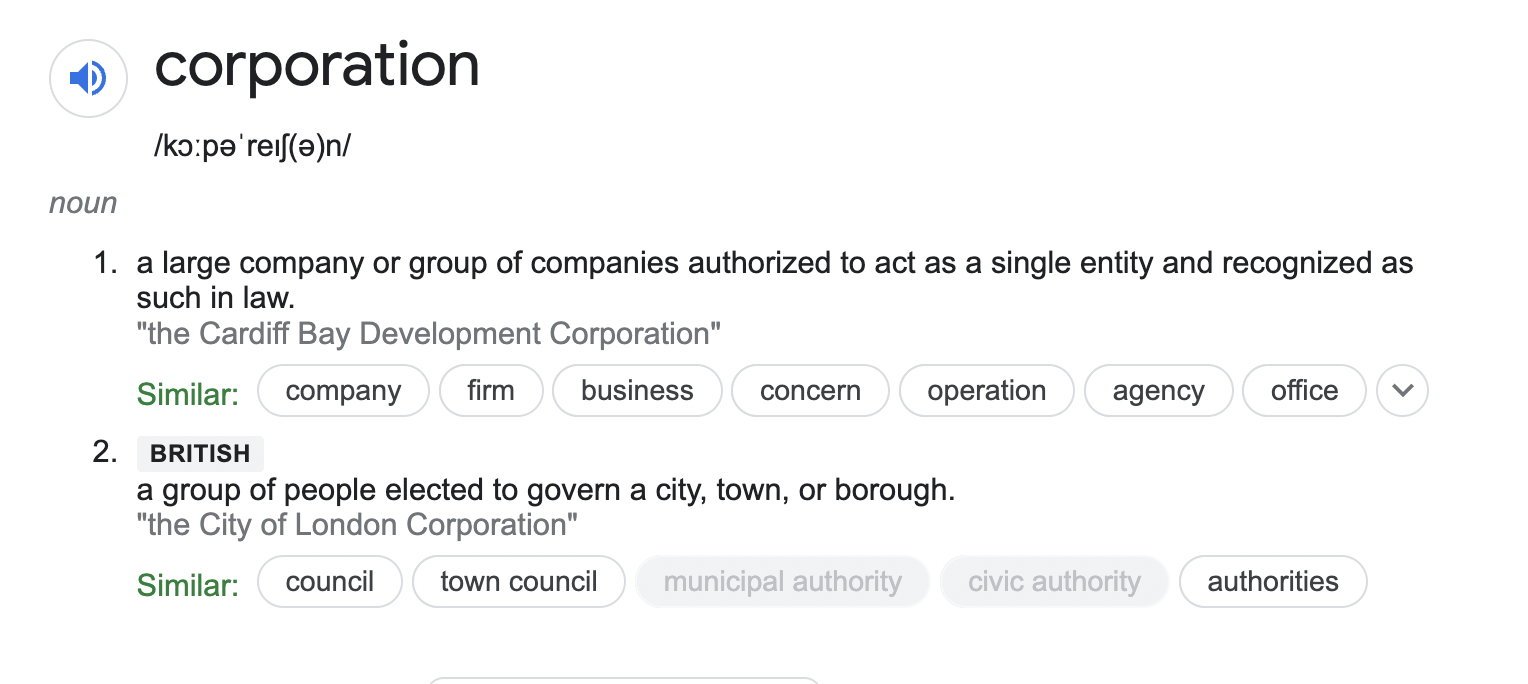The History of Corporations in Legal English

Legal English Innovation

The History of Corporations

The Language of Company Meetings

Quick Guide
Take our quiz here to test your knowledge on prepositions.
What is a corporation in Legal English?

NOTE: In British English, a corporation is known as a company. An independent entity owned by shareholders and managed by directors.
Lets take look back at the history of corporations for both sides of the pond.
UK

The modern concept of a corporation, as a separate legal entity with the power to own property, enter into contracts, and sue and be sued in its own name, emerged in the early modern period. In 1600, the British East India Company was founded, and it became the first joint-stock company to issue shares of stock to the public. This allowed investors to share in the profits of the company without being involved in day-to-day operations.
During the 18th and 19th centuries, the British economy grew rapidly, and the formation of corporations increased. Many of these corporations were formed to exploit the resources of the British Empire, such as the Royal African Company, which was founded in 1660 to trade in slaves.
In the 19th century, the Industrial Revolution led to the rise of large corporations in Britain, particularly in the manufacturing sector. These corporations, such as the British Steel Corporation and the National Coal Board, were often owned by the government and were part of the nationalized industries.
Furthermore, in the 20th century, the trend towards nationalization continued, and many large corporations were taken over by the government. However, in the 1980s, the government under Margaret Thatcher embarked on a program of privatization, selling off many of these nationalized corporations to private investors.
US

The history of American corporations dates back to the colonial era when companies such as the Dutch East India Company established trading posts in North America. However, it was not until the late 19th century that corporations began to dominate the American economy, due in part to the growth of railroads and the development of new technologies.
During the early 20th century, the rise of industrialization led to the formation of many large corporations in America, including General Electric, AT&T, and Ford Motor Company. These companies employed thousands of workers and contributed to the growth of the American middle class.
In the mid-20th century, corporations became more diversified and expanded into new industries such as finance, telecommunications, and healthcare. This trend continued into the 21st century, with companies like Google, Amazon, and Apple becoming household names and dominant players in their respective industries.
However, the history of American corporations is not without controversy. Some corporations have been accused of exploiting workers, engaging in anticompetitive practices, and damaging the environment. In response, there have been movements to increase corporate accountability and responsibility, including the development of corporate social responsibility and sustainable business practices.

Legal English Innovation
Main types of corporations in Legal English
UK

Private Limited Company (LTD)
Public Limited Company (PLC)
US

Limited liability company (LLC)
S – corporation (s-corp)
C – corporation (c-corp)
New Corporate Vocabulary
a sole proprietorship
a partnership
a legal entity
to get sued
to go after
a debt
a shortfall
to manage
double taxation
a board of directors
the day-to-day operations
a pass-through entity
a dividend
a profit
We can teach you legal English.


Legal English Innovation

Listening Activity Part 1
Area of law: Company/Corporate Law
Types of Corporations
Listening task: Take notes
Timing: This listening is 2 minutes and 30 seconds long
In today’s talk, I’ll be addressing the question of what a corporation is, specifically how it differs from a sole proprietorship or partnership. A corporation is a separate and distinct legal entity. This means that it can open a bank account, own property and do business, all under its own name. The main advantage of a corporation is that its owners, known as stockholders or shareholders, are not personally liable for its debts and liabilities. For example, if a corporation gets sued and is forced into bankruptcy, the “owners” will not be required to pay the debt with their own money. If the assets of the corporation are not enough to cover the debts, the creditors cannot go after the stockholders, directors or officers of the corporation to recover any shortfall.
A corporation is managed by a board of directors, which is responsible for making major business decisions and overseeing the general affairs of the corporation. These directors are elected by the stockholders of the corporation. Officers, who run the day-to-day operations of the corporation, are appointed by the directors.
One major disadvantage of a traditional corporation is double taxation. A traditional corporation, known as a “C-corporation”, pays corporate tax on its corporate income (the first tax). Then, when the C- corporation distributes profits to its stockholders, the stockholders pay income tax on those dividends (the second tax).
One way to avoid double taxation is to choose to be taxed as a pass-through entity, like a partnership or a sole proprietorship. That way, there is only one level of taxation. The corporate profits “pass through” to the owners, who pay taxes on the profits at their individual tax rates. Corporations that make this tax election are known as “S-corporations”.
How was your comprehension? Did you understand 65, 75, 85, or 95%?
Reading and listening simultaneously and focusing on each and every vocabulary word technical term, and detail is a strategy to help you improve your listening.

Legal English Innovation

Food for Thought
Create an answer and a defense for the following questions.
1. In your opinion, what do you think is the main function of a corporation?
2. What are the secondary responsibilities and functions of a corporation?
3. How important is Corporate Social Responsibility?
4. Name one corporation that you look up to, and one that questions your ethic.

Who’s Who
Discuss the following questions with your classmates in an open debate. Remember to join the conversation by stating “this is your name“. This will keep the conversation organized and polite, and if you have any questions or comments please do not hesitate to ask.
1. Executives
a. Is the compensation fair?
b. Should they be personally liable?
c. How important are they in the performance of the company?
2. Shareholders
a. Is the only objective to earn a profit?
b. Should shareholders/members be responsible beyond the extent of their investment?
3. Employees
a. How important are the employees in a corporation?
b. What is the biggest advantage and disadvantage of being an employee?
4. Other Stakeholders
a. Who are the stakeholders of a corporation?
b. How can stakeholders be protected?

Legal English Innovation

Listening Activity Part 2
Area of law: Company/Corporate Law
Section 5 – Advantages and Disadvantages of a Corporation
Listening task: Take notes and organize a presentation setting out the advantages and disadvantages of a corporation.
Timing: This listening is 3 minutes and 30 seconds long.
So, as I was saying, corporations enjoy many advantages over other business entities. However, the main advantage of corporations, and remember this, all those future risk takers among you, is that stockholders are not liable for corporate debts. This is the most important characteristic of a corporation. In contrast, in the case of sole proprietorships and partnerships, the owners are personally responsible for the debts of the business. If the assets of the sole proprietorship or partnership cannot satisfy the debt, creditors can go after each owner’s personal bank account, house, etc. to make up the difference. As we’ve seen, if a corporation runs out of funds, its owners are usually not liable.
The second benefit of corporations is self-employment tax savings. Earnings from a sole proprietorship are subject to self-employment taxes. With a corporation, only salaries (and not profits) are subject to such taxes.
The third advantage of a corporation is its continuous life. The life of a corporation, unlike that of a partnership or sole proprietorship, does not expire upon the death of its stockholders, directors or officers.
The fourth advantage is the fact that it’s easier for a corporation to raise money. A corporation has many avenues to raise capital. It can sell shares, and it can create new types of stock, with different voting or profit characteristics.
The fifth and last advantage is the ease of transfer. Ownership interests in a corporation may be sold to third parties without disturbing the continued operation of the business. The business of a sole proprietorship or partnership, on the other hand, cannot be sold whole; instead, each of its assets, licenses and permits must be individually transferred, and new bank accounts and tax identification numbers are required.
Right, let’s move on to the disadvantages. The first of these drawbacks is the higher cost.Corporations cost more to set up and run than a sole proprietorship or partnership. For example,there are the initial formation fees, filing fees and annual state.
The second disadvantage is the formal organization and the corporate formalities. A corporation can only be created by filing legal documents with the state. In addition, a corporation must adhere to technical formalities. These include holding board and shareholder meetings, recording minutes, having the board of directors approve major business transactions, and corporate record-keeping. If these formalities are not observed, the stockholders risk losing their personal liability protection. While observing corporate formalities is not difficult, it can be time consuming. This is not the case with either a sole proprietorship or a partnership, both of which can commence and operate without any formal organizing or operating procedures, not even a written agreement.
The third and final disadvantage is unemployment tax. A stockholder-employee of a corporation is required to pay unemployment insurance taxes on his or her salary, whereas a sole proprietor or partner is not.

Legal English Innovation

Legal English Innovation

US Legislation
The Sherman Antitrust Act of 1890
Delaware enacted its General Corporation Law in 1899
Securities and Exchange Act of 1934

UK Legislation
The Bubble Act 1720’s
The Joint Stock Companies Act 1844
The Companies Act 1862
The Companies Act 2006

Legal English Innovation
Writing Activity

Area of Law: Company Law
Writing Task: set out a letter to a client advising on setting up a corporation. Point out the advantages and disadvantages to help them in their decision making. Maintain a formal register.
Word count: 400 words
The Essays of Warren Buffett: Lessons for Corporate America
The fifth edition of The Essays of Warren Buffett: Lessons for Corporate America continues a 25-year tradition of collating Warren Buffett’s philosophy in a historic collaboration between Mr. Buffett and Prof. Lawrence Cunningham. As the book Buffett autographs most, its popularity and longevity attest to the widespread appetite for this unique compilation of Mr. Buffett’s thoughts that is at once comprehensive, non-repetitive, and digestible. New and experienced readers alike will gain an invaluable informal education by perusing this classic arrangement of Mr. Buffett’s best writings.

Legal English Innovation
About the Author
Eric Froiland
Eric is a legal English teacher from the United States and has been based out of Bogota, Colombia for the last 10 years. He is the owner and founder of Legal English Innovation SAS, which is recognized as the top legal English academy in Colombia and is an official Test of Legal English Skills (TOLES) examination center.






